There’s storage, and then there’s insane storage like the RocketAIC, which can deliver up to an incredible 56 GB/s of bandwidth. A single add-in card with 64TB of high-end, PCIe 5.0 SSDs ready to plop into an x16 PCIe slot of your choice? That’s the HighPoint RocketAIC 7608AW. We’re no strangers to high-end storage solutions, but this is the fastest thing we’ve tested to date, and it’s not even close. This wouldn’t be so awe-inspiring if it didn’t include the first and only 8TB high-end PCIe 5.0 SSD to date: the Samsung 9100 Pro, which we only reviewed recently. This is dialed up to 11 and impressively remains easy to handle, with no serious cooling concerns.
That’s because HighPoint includes a software suite for direct monitoring and management of your drives or arrays, with an actively cooled aluminum heatsink and dual-layer thermal padding to keep everything tight. You can get out-of-this-world bandwidth with capacities rivaling even the largest HDDs with just a single PCIe slot. Yeah, this means some serious power consumption, but in the grand scheme of things, SSDs are pretty power-efficient. There’s really no substitute for this level of performance if you’re someone actively engaged in AI, serious content creation, or SOHO server tasks.
On the other hand, this solution doesn’t really make sense for everyday use. You can make do with fewer, smaller SSDs and save a lot of money, even if the total bandwidth is lower. The price of the RocketAIC really puts it out of the reach of the average consumer. That’s not due to just the price of the AIC itself, but rather the fact that if you’re spending that much on the AIC, then you really should have some serious SSDs to match. There’s no real halfway point. However, for $10,000 MSRP, you can have the exact setup we’re testing today, which isn’t that crazy for serious setups, especially considering the NAND flash shortage at our doorstep.
HighPoint RocketAIC 7608AW Specifications
Swipe to scroll horizontally
Feature | Description |
Price (AIC) | $1,999.00 |
Port/Drive Count & Speed | 8x NVMe, x4 PCIe 5.0 |
Connector Type | Tool-less M.2, 2242/2260/2280 |
Cooling | AL heatsink w/ active fan, 2-layer thermal padding |
External Connectors | 6-pin PCIe power |
Form Factor | FH-HL (167mm x 110mm, 284mm x 110mm) |
Upstream Lanes | x16 PCIe 5.0 |
Downstream Lanes | x32 PCIe 5.0 |
Maximum Bandwidth | Up to 56,000 MB/s (60,000) |
RAID Support | RAID 0, RAID 1, RAID 10 (HW) |
Encryption | SafeStorage TCG Opal (HW) |
Features | Hardware Secure Boot |
| Row 13 - Cell 0 | Comprehensive Health & Management |
| Row 14 - Cell 0 | Self-Diagnostic, FRU |
| Row 15 - Cell 0 | Environment Sensor, Logging, LEDs |
| Row 16 - Cell 0 | WebGUI, CLI, API, UEFI |
Power | Up to 82.64W |
FW Customization | SMBus, I2C, MCTP over PCIe |
Software OS Support | Windows, Linux |
The RocketAIC 7608AW is currently available for $1,999.00 with the ability to take up to eight PCIe 5.0 SSDs for a maximum bandwidth potential of at least 56,000 MB/s. If this sounds familiar, it’s because we reviewed a similar solution in the HighPoint Rocket 1608A last year. Back then, we were dealing with PCIe 4.0 drives, specifically the 2TB Samsung 990 Pro. It would have been nicer to have had the 4TB 990 Pro, a drive that remains the best 4TB PCIe 4.0 drive on the market, but 2TB was more accessible at the time. Samsung and HighPoint have learned from that, potentially, as today we have the AIC filled with 8TB Samsung 9100 Pros. The 9100 Pro is the first 8TB PCIe 5.0 consumer SSD we’ve tested and is therefore perfect for showing off what this AIC can do. Mind you, the AIC will cost you $500 more this time around, in what is a bit of a revamp.
The AIC has eight tool-less M.2 slots with up to x4 PCIe 5.0 lanes per slot, ready to take drives from 2230 to 2280. 22110 would have been a tall order, but some users may have liked that option. You can only fit so much on a standard AIC. In any case, this means a total of x32 downstream lanes with up to x16 PCIe 5.0 lanes upstream. Theoretically, this could hit 64 GB/s, but the AIC is listed as up to 60 GB/s, technically, with only 56 GB/s fully promised. This is still very fast, and the throughput efficiency reflects diminishing returns.
The AIC has a host of features that help set it apart from your typical multi-drive cards. It supports hardware RAID 0, 1, and 10, with Hardware Secure Boot and hardware encryption (SED) via TCG Opal. The drives can be easily and fully monitored to ensure everything stays healthy, under Windows or Linux, with WebGUI and CLI access. The hardware is kept cool with an aluminum heatsink, generous two-layer thermal padding, and an active fan. We recommend visiting HighPoint’s website for a full reading of supported features.
HighPoint RocketAIC 7608AW Software and Accessories
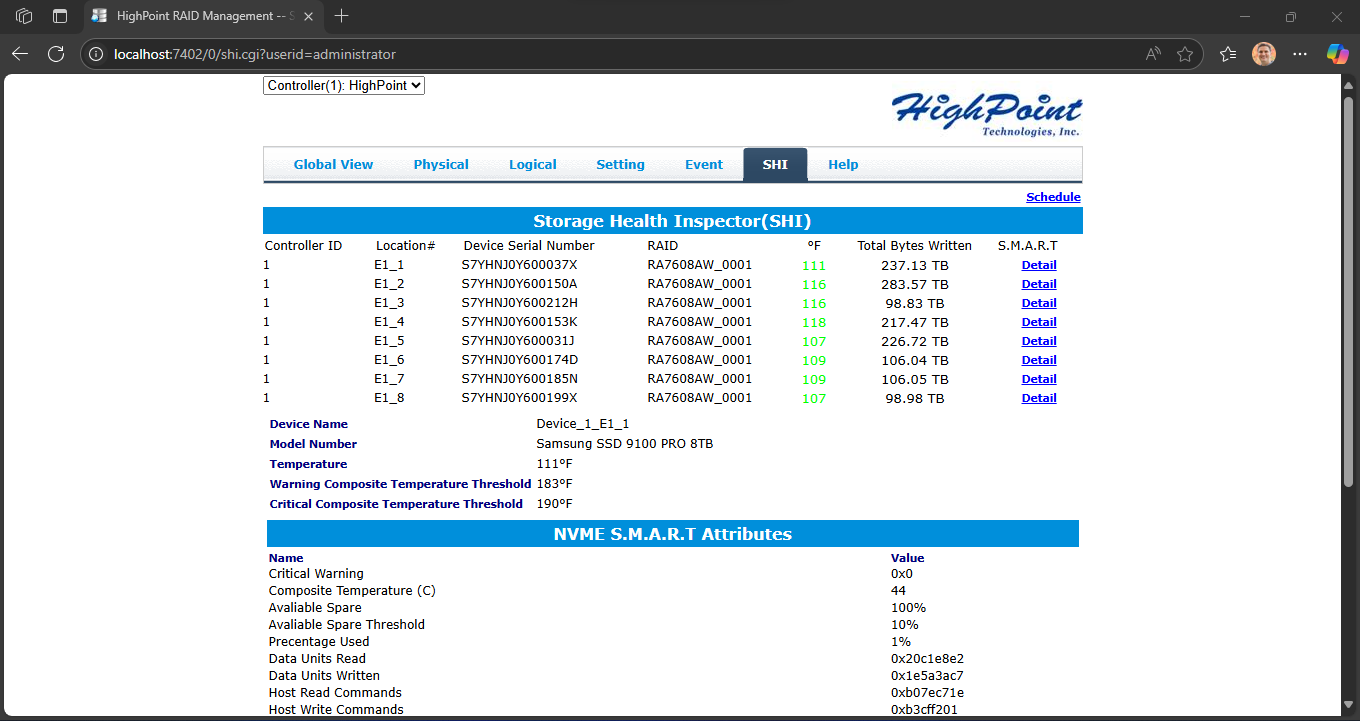
Unlike most of the storage products we review, HighPoint actually has some noteworthy software for the RocketAIC 7608AW. This isn’t surprising given that this is a serious RAID solution that will cost you a pretty penny. Also, unlike other products, Linux is supported. HighPoint offers specific downloads for the Rocky Linux, Red Hat, Ubuntu, and Debian distributions, as well as a way to build the drive module for custom Linux kernels. We’re using Windows and accessing the software through a browser, though.
The RAID management software has everything you need to track drive health in real time with logging and notification. This type of software might be new to those who are used to regular consumer SSDs that you just drop into the system with minimal hassle, but it’s expected for veteran users of Unraid, TrueNAS, Webmin, etc. While the WebGUI is the most user-friendly approach, there’s also command line (CLI) and UEFI-HII access. HighPoint provides you with everything you need to hit the ground running.
HighPoint RocketAIC 7608AW : A Closer Look

There’s not too much excitement here on the back, but we will point out two ICs. The first is the Winbond chip labeled 25Q256JWFQ, which is a 256Mbit (32MiB) NOR flash memory chip. Attentive readers will remember that we had 4MiB Winbond NOR flash chips in the newest 30TB Seagate drives, the Exos M and IronWolf Pro. NOR flash is often used for firmware and storing executable code, offering higher reliability than NAND flash and unique performance characteristics that are beneficial for RAID and storage controllers. The RocketAIC 7608AW is a serious controller and therefore requires more memory.
The second prominent IC on the rear is labeled 9ZXL1251EIL. This is a 12-output PCIe buffer which is used to, in short, maintain signal integrity. Doing so at PCIe 5.0 speeds with 48 total lanes – 8x4 for the SSDs, and x16 upstream – is challenging, and so an IC capable of having one buffer per SSD is necessary. Considering that these drives are intended to be used in a RAID, timing is especially important for maximum performance and reliability. The controller also helps reduce load on the host CPU and system with this management, which is an advantage over homebrew configurations.
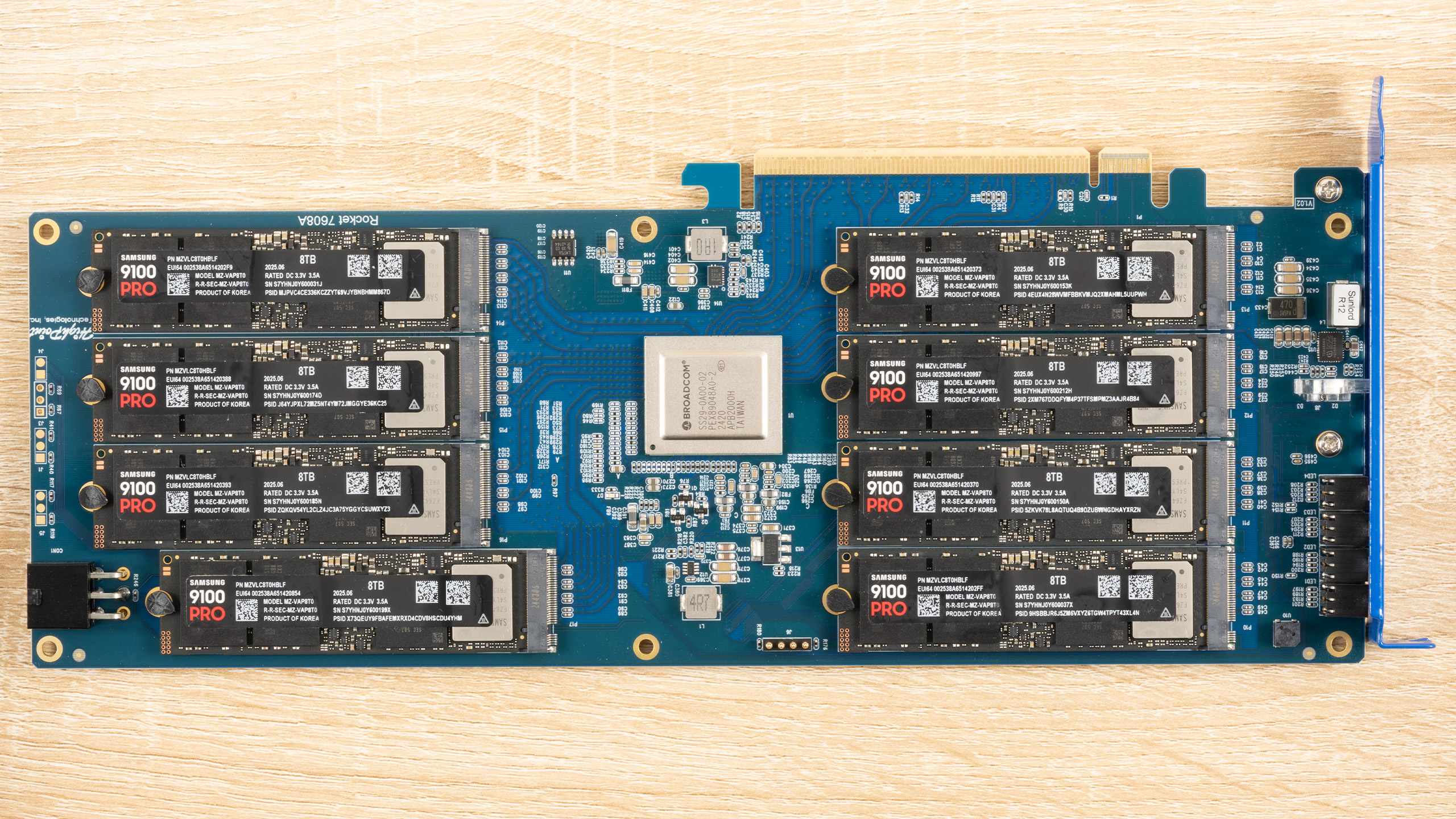
The top side is more interesting. Here we can see the RAID controller and the eight M.2 slots, each slot filled with an 8TB Samsung 9100 Pro. There is a PCIe power connector at one end and status LEDs at the other. If the controller looks familiar, it’s because it’s the same one on the HighPoint Rocket 1608A. We recommend checking that review first for a deeper technical discussion. Broadcom’s PEX89000 Series offers PCIe switches for up to PCIe 5.0 speeds across 24 to 144 lanes. There are many optional features, but most of these are interesting for more serious use cases than would be the case with use at home or even for SOHO. If we look into Broadcom’s wider PCIe switch documentation, we can get additional information on this hardware.
The PEX89048 switch has 48 lanes and up to 48 ports, with usually 32 lanes downstream – 4 for each of 8 SSDs – and 16 lanes upstream. The switch uses a dual-core ARM A15 architecture, which is more powerful than the ARM-based controllers found in typical SSD controllers. This is obvious from the power draw, with 23.7W being typical of the switch, while even the most power-hungry consumer SSD tops out around 11.5W with the rest of the hardware. This switch does require cooling, but has a large surface area to help. The switch also lists a latency of 115ns, which is within the ballpark of typical PCIe switches – this would include the PCH or chipset on your motherboard, if an SSD is using lanes over that rather than from the CPU – and is a tiny amount of added delay when the vast majority of access latency exists at the flash media level.
MORE: Best SSDs
MORE: Best External SSDs

 1 week ago
8
1 week ago
8
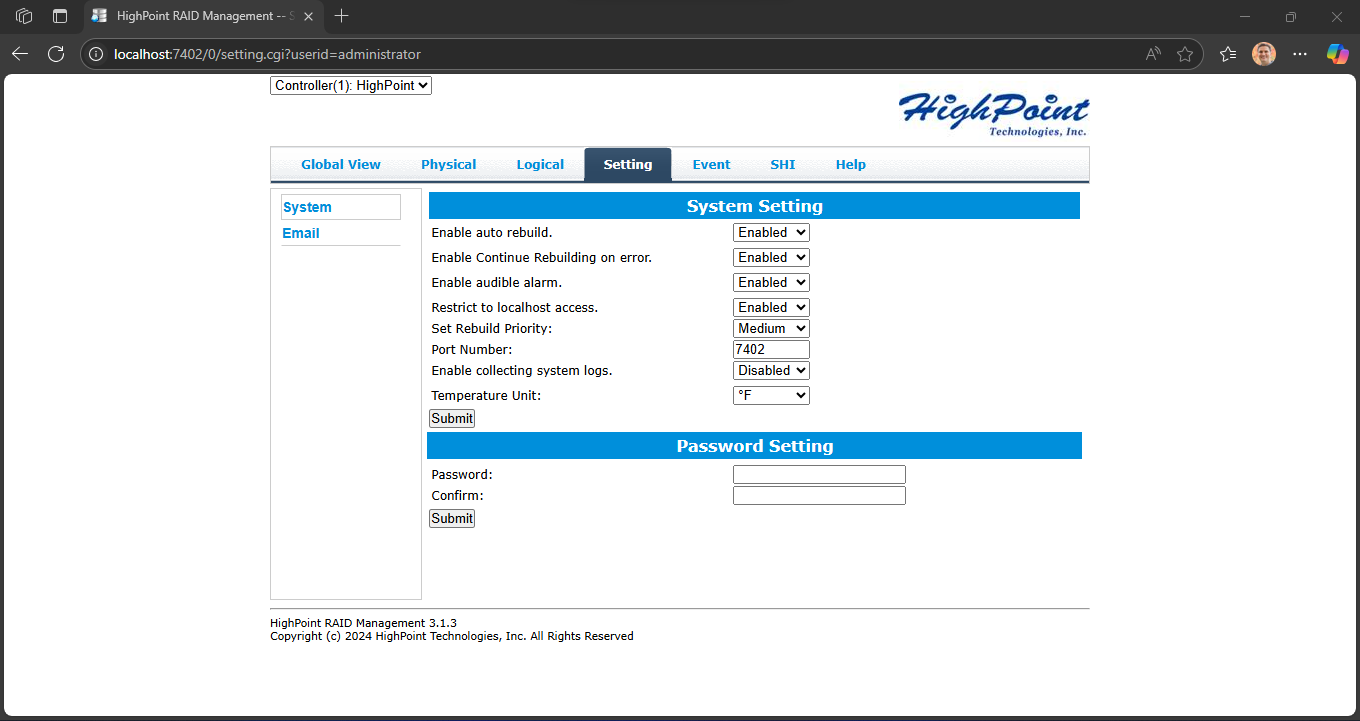
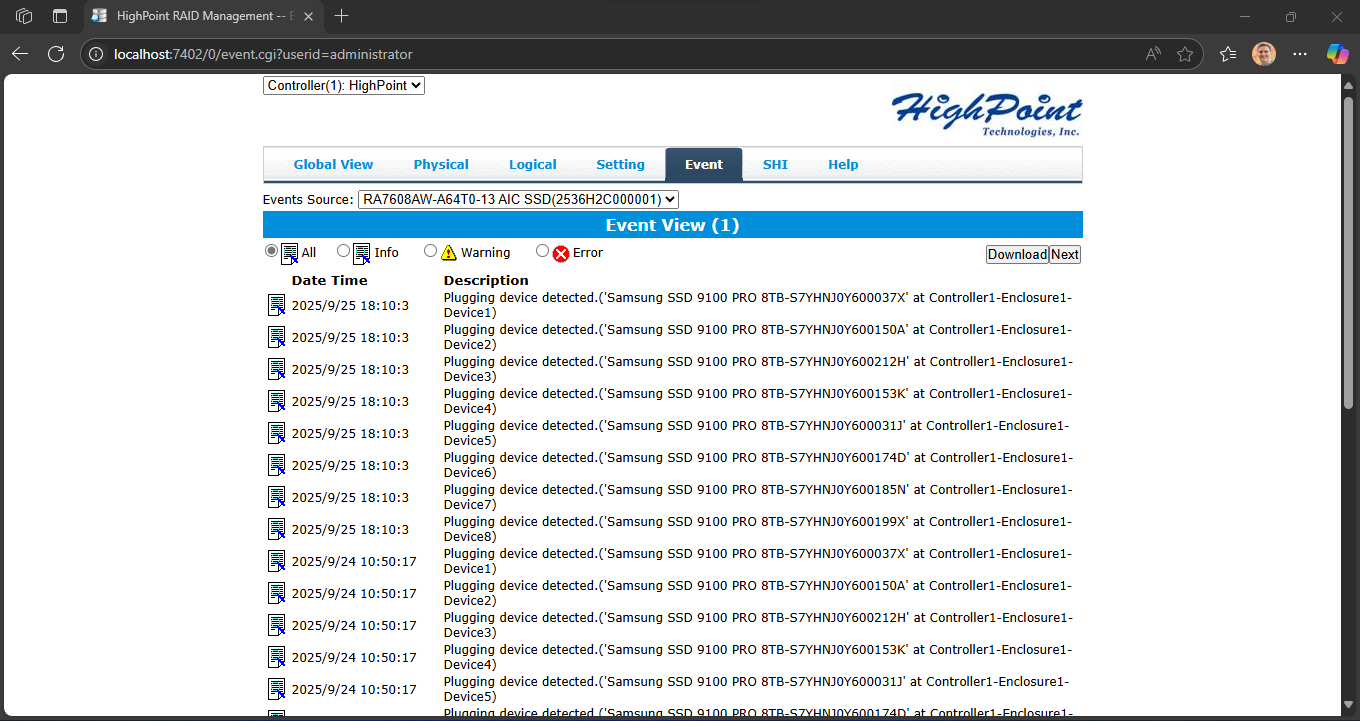



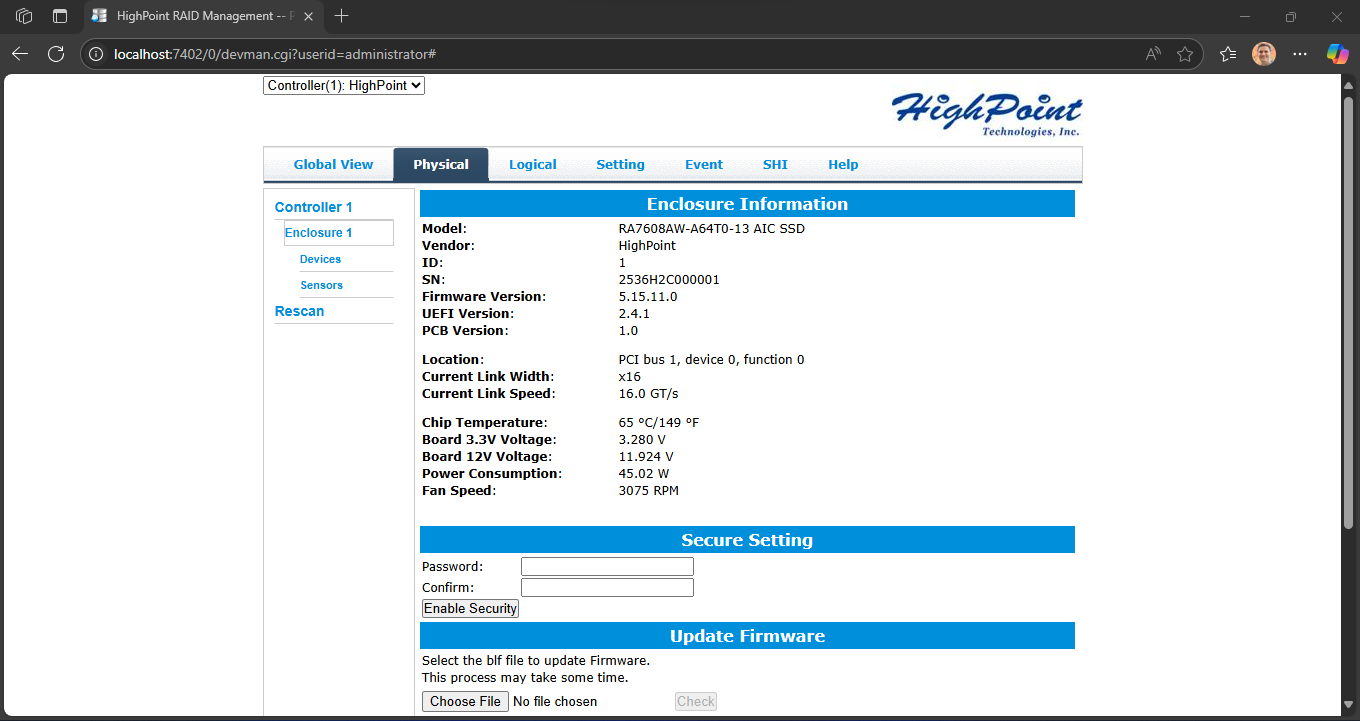
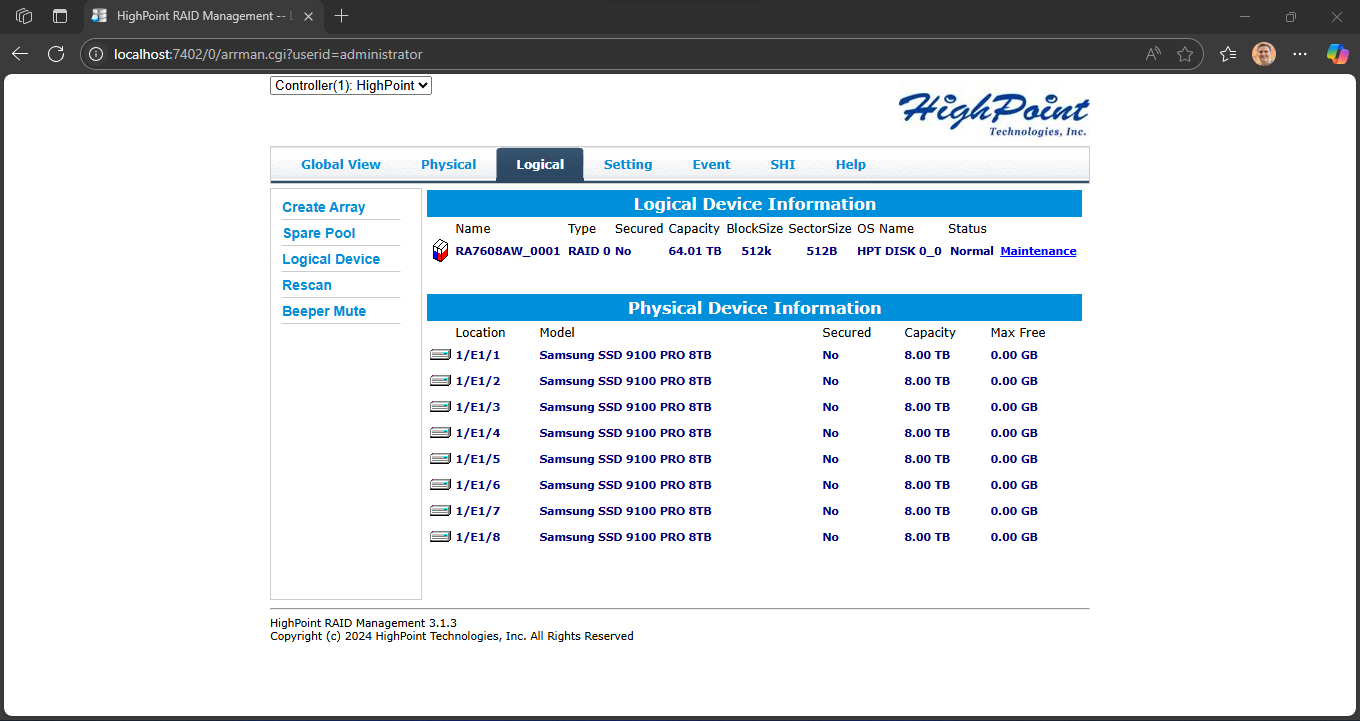

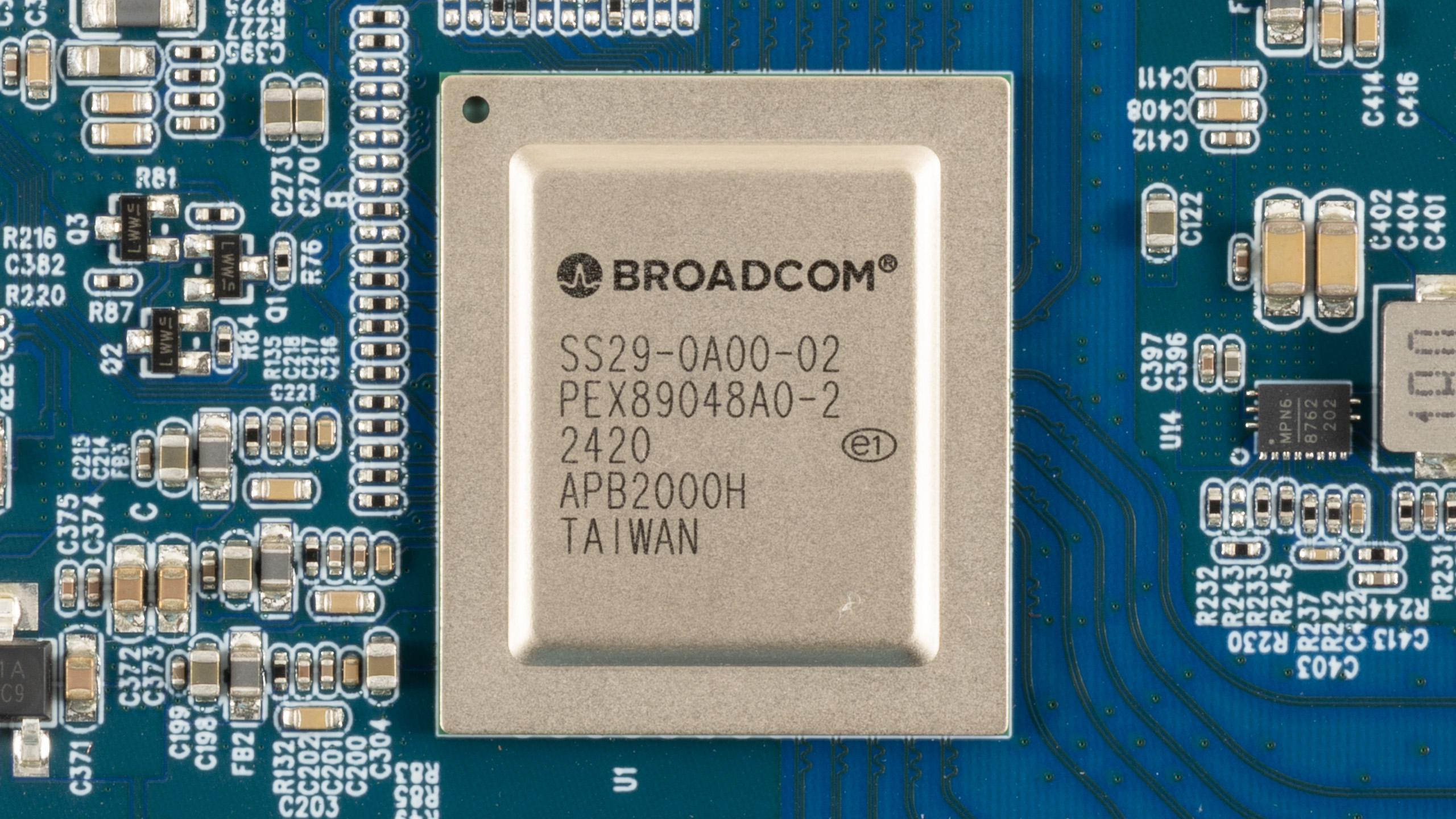




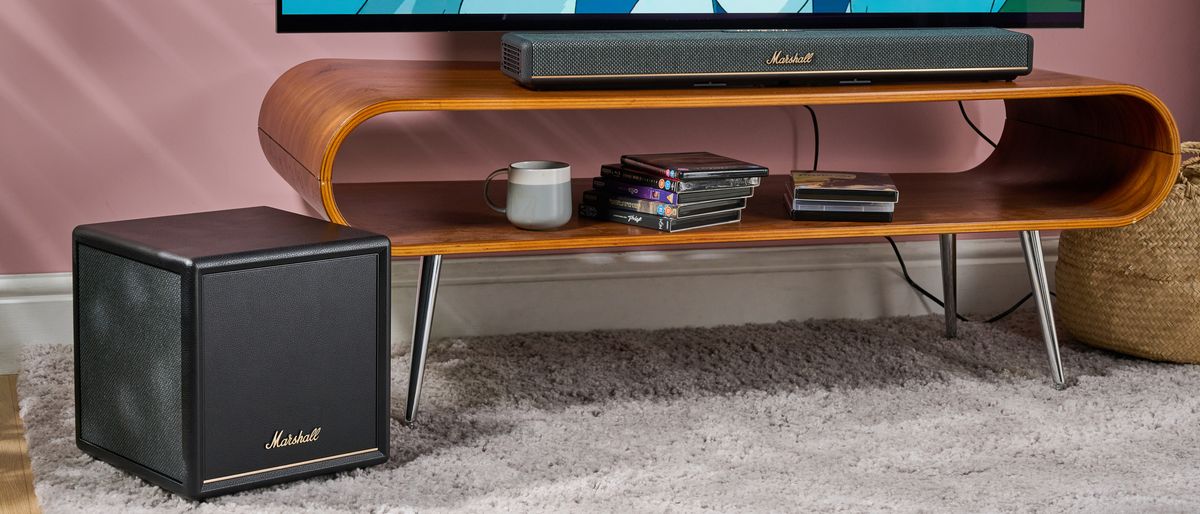





 English (US) ·
English (US) ·